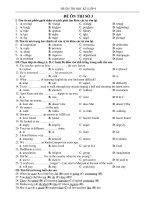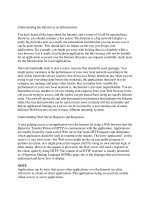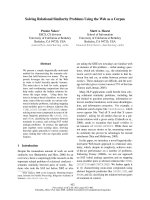New stories - The learner as storyteller
Bạn đang xem bản rút gọn của tài liệu. Xem và tải ngay bản đầy đủ của tài liệu tại đây (128.53 KB, 16 trang )
48
Text © Sagrario Salaberri Design and illustration © Macmillan Publishers Ltd 1995
New stories
The learner as storyteller
Whenever learners are allowed to spend a certain amount of class time telling stories
about their past experiences in their own language, the educational benefits are twofold:
we are helping them to develop their storytelling ability and also feel more in control of
emotional factors such as self confidence and inhibition. This sharing time, as it is
sometimes called, is not easy to achieve in the foreign language classroom. Often low
level learners do not have the linguistic resources to tell stories in English, although they
may often want to do so. However, we feel that learners can often say more than
expected, provided they have enough stimulus, prompts and, of course, the necessary
vocabulary provided by the teacher. There are two key factors for the success of
storytelling activities. One is the role of teacher as guide and helper and the other is the
setting up of an appropriate context. This chapter aims to describe how to get learners to
tell stories in English and is divided into three sections with activities which range from
limited learner participation to considerable learner participation.
Activity 1
The first activity does not require the class to tell stories but to select ones they would like
to have read to them. To do this you can set up a story box with a list of titles of the
stories you can read over the year and get the class to select the ones they would like and
the order in which they would like to hear them. You can do the same with readers which
have simplified versions of stories. When dealing with stories that the class do not know,
it is worth getting them to look at the cover and inside cover, the illustrations, the list of
contents etc so that they get an idea of what the story is about. This also helps to
establish which are the most popular stories for use with successive classes and those
which can be exchanged with the titles chosen by other classes. Once the class have
selected the stories and established an order for them, a regular day for storytelling can be
fixed which helps both teacher and learners to do the pre-activities to the stories (draw
pictures of the characters, revise useful vocabulary, imagine an alternative ending, etc).
Once you have told the stories in class, they can be recorded onto audio tape for later use.
This provides a permanent selection of stories that the class can listen to or read whenever
they like.
Activity 2
Get the class to make flashcards of stock characters for use when improvising tales and
for illustrating a range of different stories. The characters they can draw and label are:
Princess, Prince, Witch, King, Queen, Fairy, Giant, Frog, Wizard.
6
Limited learner
participation
Text © Sagrario Salaberri Design and illustration © Macmillan Publishers Ltd 1995
49
CHAPTER 6 New stories The learner as storyteller
50
Text © Sagrario Salaberri Design and illustration © Macmillan Publishers Ltd 1995
CHAPTER 6 New stories The learner as storyteller
Give out the flashcards and get the class to improvise a story beginning Once upon a
time… and introducing the characters one by one. You can assign further roles or
characters so that the whole class gets a chance to contribute. In addition to characters,
the class can also produce cards with the pictures and names of different actions and of
magic objects (a wand, broom, magic mirror, etc) so that the story can be told in a more
detailed way. If the class has a particularly large number of learners, it is advisable to get
one group to demonstrate the activity first so that the others know exactly what to do.
Activity 3
This activity shows learners how to invent chain stories. Get one of the class to suggest
the name of a well-known character (for example, Charlie Brown). Write the following
headings and example on the board:
Questions Answers
What is your name? Charlie Brown
Continue asking the class questions such as those in the list below and writing the
answers on the board (or letting a volunteer write them up).
How old are you?
Where do you live?
Who is your teacher?
What is your favourite sport?
How many brothers and sisters have you got?
Have you got a pet?
Once all the answers are up on the board, tell the class that they are going to work
together to imagine a day in the life of Charlie Brown (for example, last Saturday). Make
sure you ask very specific questions, such as those in the list below, that can be answered
in a few words. Make sure the class realise that any new answers must not contradict
earlier ones. You can nominate members of the class to be reporters who write down the
answers and point out if anyone makes a mistake. These reporters can then describe the
day in Charlie Brown’s life based on the answers given by the rest of the class.
When did you get up?
What TV programme did you watch during breakfast?
What did you do after breakfast?
What song did you listen to?
Where did you go with Snoopy?
This second section includes activities designed to take stories or parts of stories from
stories the class already know.
Greater learner
participation:
telling stories
from stories
Text © Sagrario Salaberri Design and illustration © Macmillan Publishers Ltd 1995
51
CHAPTER 6 New stories The learner as storyteller
Activity 1
This activity is based on using very well-known stories but telling them with some
deliberate changes. It can be used in two ways: by getting the class to invent the
changes and build them into the story or by getting the class to listen out for them as
you read the story.
LITTLE RED RIDING HOOD
(A New Version)
Little Red Riding Hood’s mother says, ‘Grandma is on the phone. She
says she’s ill. Why don’t you get your motorbike and take her some
magazines?’
‘OK,’ says Little Red Riding Hood. ‘I will.’
‘Be careful with the traffic. Don’t go too fast,’ warns her mother.
Little Red Riding Hood drives to her grandmother’s. When she gets
there, she knocks on the door.
‘Come in,’ says grandmother. ‘The door is open.’
When Little Red Riding Hood walks into the bedroom, Grandmother is
listening to rock music on her Walkman.
‘Grandma,’ says Little Red Riding Hood. ‘This is a surprise! You like
rock music!’
‘Yes,’ says Grandma. ‘I listen to a lot of rock every day.’
‘And Grandma,’ says Little Red Riding Hood.‘You like reading
comics!’
‘Yes,’ says Grandma. ‘I read a lot of comics every day.’
‘And Grandma,’ says Little Red Riding Hood. ‘You like chewing gum!’
‘Yes,’ says Grandma. ‘I like chewing gum but I like little girls like you
better.’
Suddenly, Little Red Riding Hood takes an aerosol out of her pocket
and sprays Grandma until she faints.
‘I knew you were not Grandma.’
Later, she finds her grandmother hiding in the garage.
‘Thank you,’ says Grandma. ‘That burglar wanted to steal all my
things.’
‘I know how to deal with burglars,’ says Little Red Riding Hood,
putting the spray back into her pocket. ‘Let’s call the police.’
52
Text © Sagrario Salaberri Design and illustration © Macmillan Publishers Ltd 1995
CHAPTER 6 New stories The learner as storyteller
Activity 2
Get the class to identify and write down all the changes as they listen to the story. This
can be done in note form and in the learners’ own language.
Activity 3
Once the class have made notes of the differences between the two versions, they can
read the new version a second time and do the following more controlled activity.
1 Write differences between the traditional tale and this one.
Traditional
Little Red Riding Hood lives in a small town.
Little Red Riding Hood hasn’t got a telephone.
Little Red Riding Hood takes Grandma some cakes.
Little Red Riding Hood walks to Grandma’s.
Little Red Riding Hood must walk through a forest.
Little Red Riding Hood says, ‘Your eyes are very big.’
Little Red Riding Hood says, ‘Your ears are very big.’
Little Red Riding Hood says, ‘Your mouth is very big.’
Grandma is really a wolf.
Little Red Riding Hood cries, ‘Help!’
Little Red Riding Hood’s father kills the wolf.
Grandma is hiding in a cupboard.
In the end, they lived happily ever after.
New version
................................................................................................................
................................................................................................................
................................................................................................................
................................................................................................................
................................................................................................................
................................................................................................................
................................................................................................................
................................................................................................................
................................................................................................................
................................................................................................................
................................................................................................................
................................................................................................................
................................................................................................................
Text © Sagrario Salaberri Design and illustration © Macmillan Publishers Ltd 1995
53
CHAPTER 6 New stories The learner as storyteller
Activity 4
This activity gets the class to tell stories the wrong way round, starting with the end.
Choose a traditional story like the one below. Prepare the vocabulary first and hand out
copies of the following key words. Allow the class to take notes on what happens in the
story as they listen.
Telling a story the wrong way round is easier if the story is simple and repetitive as in the
example here. Once you have told the story, divide the class into groups and get the
learners to reconstruct the story in the following order, starting with the end.
T
HE
V
AIN
L
ITTLE
M
OUSE
Little Mouse lived in a beautiful little house. One day, when she was
sweeping the floor, she found a coin.
She said,‘With this coin, I’m going to buy a nice red bow for my hair.
I’ll look beautiful!’
She was really beautiful with the red bow in her hair. She sat next to
the window so that everybody could see her.
‘Little mouse, you do look pretty,’ said the donkey. ‘Will you marry
me?’
And she asked, ‘What will you do at night?’
‘I will bray like this,’ said the donkey. And he brayed.
‘Oh no, I’ll get frightened,’ said the mouse.
Then the dog asked her, ‘Little mouse, you are beautiful. Why don’t
you marry me?’
‘What will you do at night?’ asked the mouse.
‘I will bark like this,’ said the dog. And he barked.
‘Oh no, I’ll get frightened,’ said the mouse.
Finally, the cat asked her, ‘Beautiful little mouse, will you marry me?’
‘And what will you do at night?’ asked the mouse.
‘I will sing like this,’ said the cat. And he sang a beautiful song.
‘Yes, I will marry you,’ said the mouse.
So they got married, but on their wedding night, guess what! The cat
did not sing his beautiful song. He ate the vain little mouse.
1 coin 4 mouse-dog
2 bow 5 mouse-cat
3 mouse-donkey 6 wedding night
1 wedding night 4 mouse-donkey
2 mouse-cat 5 bow
3 mouse-dog 6 coin









